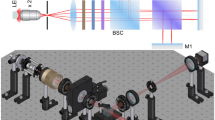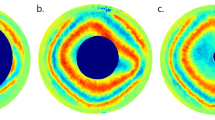Abstract
IN order to extend the range of my apparatus for measuring circular dichroism1, I have designed an achromatic retardation plate which will produce circular polarization in the ultra-violet.
This is a preview of subscription content, access via your institution
Access options
Subscribe to this journal
Receive 51 print issues and online access
$199.00 per year
only $3.90 per issue
Buy this article
- Purchase on Springer Link
- Instant access to full article PDF
Prices may be subject to local taxes which are calculated during checkout
Similar content being viewed by others
References
Mitchell, S., Nature, 166, 434 (1950); J. Sci. Instrum., 34, 89 (1957).
Gaudefroy, M. C., C. R. Acad. Sci., Paris, 189, 1289 (1929).
West, C. D., and Makas, A. S., J. Opt. Soc. Amer., 39, 791 (1949).
Bruhat, G., and Weil, L., Revue d'Optique, 15, 94 (1936).
See Landolt-Börnstein Tables, sixth ed., 8, (2), 427 (1962).
Author information
Authors and Affiliations
Rights and permissions
About this article
Cite this article
MITCHELL, S. An Achromatic Three-quarter Wave Plate for the Ultra-violet. Nature 212, 65–66 (1966). https://doi.org/10.1038/212065a0
Issue Date:
DOI: https://doi.org/10.1038/212065a0
This article is cited by
-
Solution-processed inorganic perovskite crystals as achromatic quarter-wave plates
Nature Photonics (2021)
Comments
By submitting a comment you agree to abide by our Terms and Community Guidelines. If you find something abusive or that does not comply with our terms or guidelines please flag it as inappropriate.



